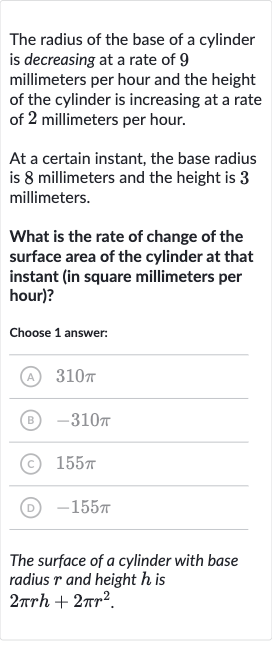AI tutor
Welcome to Bytelearn!
Let’s check out your problem:

The radius of the base of a cylinder is decreasing at a rate of millimeters per hour and the height of the cylinder is increasing at a rate of millimeters per hour.At a certain instant, the base radius is millimeters and the height is millimeters.What is the rate of change of the surface area of the cylinder at that instant (in square millimeters per hour)?Choose answer:(A) (B) (C) (D) The surface of a cylinder with base radius and height is
Full solution
Q. The radius of the base of a cylinder is decreasing at a rate of millimeters per hour and the height of the cylinder is increasing at a rate of millimeters per hour.At a certain instant, the base radius is millimeters and the height is millimeters.What is the rate of change of the surface area of the cylinder at that instant (in square millimeters per hour)?Choose answer:(A) (B) (C) (D) The surface of a cylinder with base radius and height is
- Surface Area Formula Derivative: The formula for the surface area of a cylinder is . We need to find the derivative of this formula with respect to time to find the rate of change of the surface area.
- Rate of Change Variables: Let's denote the rate of change of the radius as (since the radius is decreasing) and the rate of change of the height as (since the height is increasing).
- Derivative Calculation: Now we take the derivative of the surface area with respect to time: .
- Product Rule Application: Using the product rule for , we get .
- Substitute Values: Substitute the values of , , rac{dr}{dt}, and rac{dh}{dt} into the equation: rac{d(rh)}{dt} = 8(2) + 3(-9).
- Calculate : Calculate : .
- Calculate : Now, calculate : .
- Calculate : Calculate : .
- Final Calculation: Now we have all the parts to find : .
- Conclusion: Calculate : mm/h.
- Conclusion: Calculate : mm/h. The rate of change of the surface area of the cylinder at that instant is square millimeters per hour, which corresponds to answer choice (B).
More problems from Area of quadrilaterals and triangles: word problems
QuestionGet tutor help
QuestionGet tutor help
QuestionGet tutor help
QuestionGet tutor help
QuestionGet tutor help
QuestionGet tutor help
QuestionGet tutor help
